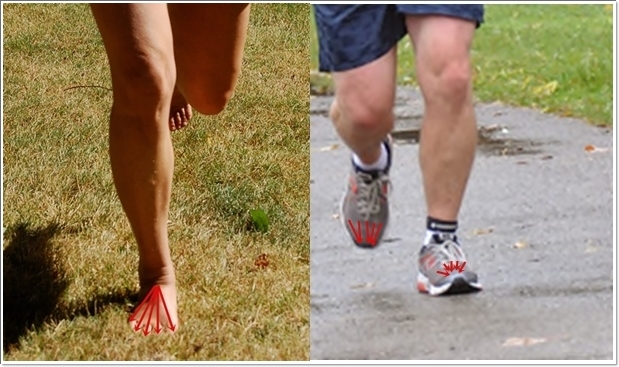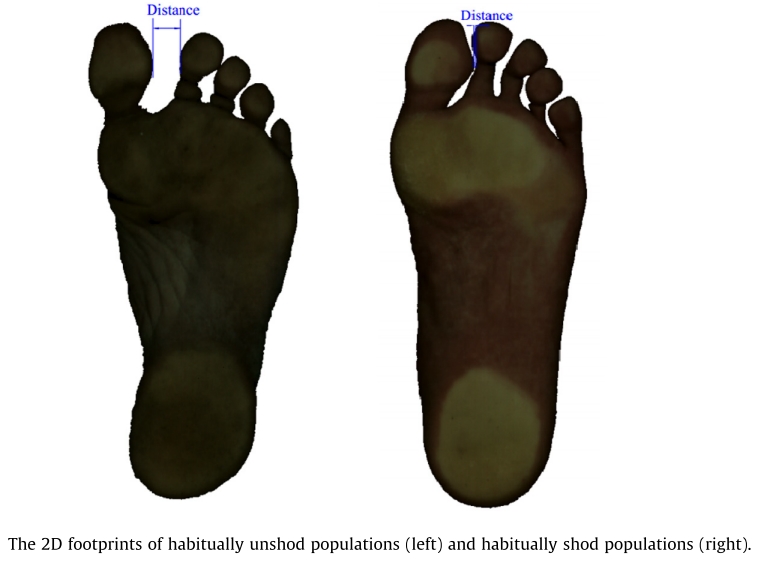Running shoes literally shape our feet. Unfortunately, most running shoes are narrow and eventually provoke a narrower forefoot that includes a bunion.
Most standard running shoes have a narrow toe-box which is a design feature that facilitates foot rollover in heel strike running. In particular, a narrower forefoot coupled with wearing standard running shoes affect plantar loading characteristics that may accelerate bunion development during running and later on life, lead to extreme bunion pain. Who needs that?

Barefoot Running May Help With Extreme Bunion Pain
The feet of an habitual barefoot runner differs anatomically from that of an habitual shod runner. For example, habitual barefoot runners were found to have a larger distance between the hallux (big toe) and the remaining toes as compared with habitual shod runners, shown below. (Mei et al. 2015).

The probability of developing a bunion can be inferred by the distance between the hallux and the remaining toes whereby a substantially small distance might indicate the early stages of bunion formation.
Shod Runners Have High Hallux Peak Pressures
Abnormally high peak plantar pressure contributes to structural changes within the foot. What is more, high peak pressures on the hallux may induce structural perturbations that contribute to bunion development.
Mei et al. (2015) found that habitual shod heel strike runners had a larger pressure in the hallux as compared with habitual barefoot forefoot strike runners.
Even worse, habitual shod forefoot strike runners had greater peak pressures in the hallux as compared with habitual barefoot forefoot strike runners, confirming that footwear were at the root of the cause.
These findings demonstrate that anatomical changes in the feet of an habitual shod runner differ markedly from those feet of habitual barefoot runners and that these changes can disrupt peak pressure patterns that would lead to bunion development or enlargement of an existing bunion.
The Take Home Message
Bunions are extremely rare in habitually barefoot populations and from this, what has changed is the realization that bunions are not hereditary. Researchers eventually pinpointed modern footwear as the sole cause of bunions.
To make up for this common foot ailment, going barefoot is the best candidate. Dont want to go barefoot? Here are my recommendations on proper footwear for running,
More From Run Forefoot:
Barefoot running sandals review
Cause of stiff knees while running
One of the most thinnest barefoot running shoes
Chronic overloading during heel running leads to PF
References:
Mei et al. A comparative biomechanical analysis of habitually unshod and shod runners based on foot morphological differences. Hum Mov Sci, 2015; 42:38-53.
Bretta Riches
BSc Neurobiology; MSc Biomechanics candidate, ultra minimalist runner & founder of RunForefoot. I was a heel striker, always injured. I was inspired by the great Tirunesh Dibaba to try forefoot running. Now, I'm injury free. This is why I launched Run Forefoot, to advocate the health & performance benefits of forefoot running and to raise awareness on the dangers of heel striking, because the world needs to know.
Latest posts by Bretta Riches (see all)
- Forefoot Running and Achilles Pain - 19/04/2024
- Does Foot Strike Really Matter in Running? YES! - 17/04/2024
- Heel Lifts Increase Injury in Runners - 16/04/2024

Leave a Reply